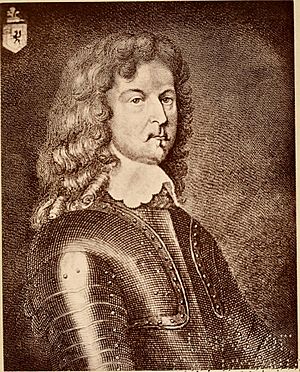John Boys (Royalist) facts for kids
Sir John Boys (born in 1607, died 8 October 1664) was a famous soldier during the English Civil War. He is best known as the brave leader of Donnington Castle in Berkshire. He fought for King Charles I and his side, known as the Royalists.
Contents
Early Life and Military Start
John Boys was born in Bonnington, a place near Goodnestone in Kent, England. He was born in 1607.
In 1641, John Boys became a lieutenant colonel. He joined the King's army in Ireland. Even though someone else was officially in charge, John Boys was the real leader of his soldiers on the battlefield.
Defending Donnington Castle
Why Donnington Castle Was Important
Donnington Castle is located north of Newbury. In 1643, King Charles I used it as a military base. The castle was very important because it controlled key roads. These roads connected places like Oxford to Southampton and London to Bath.
Sir John Boys Takes Command
From 1643, Lieutenant-Colonel John Boys was in charge of Donnington Castle. He spent a lot of money, about £1,000, to make the castle's defenses stronger. He built earthworks, which are like big dirt walls. Boys commanded about 200 foot soldiers, 25 horsemen, and 4 cannons. These forces stayed with him throughout the long sieges.
First Attack: July 1644
On 31 July 1644, Donnington Castle was attacked. An army of 3,000 horsemen and dragoons tried to capture it. This army was part of the New Model Army, which fought for Parliament. Their leader was Lieutenant-General John Middleton. However, they did not have any cannons. Middleton tried to make Boys give up, but Sir John Boys refused. The attackers were forced to leave, losing at least 300 men.
Second Attack: September 1644
About a month later, on 29 September, Colonel Jeremy Horton started a 12-day attack. He set up cannons near the castle. These cannons fired many shots, shattering the southern towers of the castle. They also broke down part of the wall. It's thought that over 1,000 cannonballs hit the castle during this time. Even though Colonel Horton had more soldiers, Governor John Boys still refused to surrender. He even bravely told Horton to give up instead!
King Charles Arrives and a Knighthood
A Parliamentarian army returned on 4 October. This time, the Earl of Manchester led them. They tried to storm the castle, but they failed. The bombing continued for several days, but Boys held strong. The whole army eventually left when King Charles I arrived with his own army. For his amazing defense of the castle, Governor John Boys was made a knight on 21 October 1644. He became "Sir John Boys." The King also promoted him to a full colonel.
Protecting the King's Cannons
On 27 October, the second battle of Newbury was fought nearby. Colonel Sir John Boys kept the King's cannons safe under the walls of Donnington Castle. After the battle, a famous Parliamentarian general, Sir William Waller, surrounded the castle. Again, Sir John Boys refused to surrender.
Later, the Earl of Essex also tried to attack Donnington Castle. But he gave up before King Charles returned in November 1644 to help the castle again. The King took his valuable items and cannons, leaving some heavier ones for the soldiers defending the castle.
The Final Surrender
After 14 November 1645, Oliver Cromwell himself focused on Donnington Castle. The next spring, a huge attack with cannons and mortars was ordered. By 30 March, a truce was agreed. King Charles had no choice but to tell Boys to surrender on the best terms possible. On 1 April 1646, the surrender was completed. Sir John Boys' soldiers were allowed to march to another Royalist castle, Wallingford Castle. They marched with their flags flying and drums beating. Sir John Boys did not join them. Instead, he went to London and did not fight anymore.
Later Life
In 1646, Sir John Boys was made Lord Warden of the Cinque Ports. This was an important job. In August 1648, he tried to help Walmer Castle in Deal, but he was not successful. Sir Algernon Sydney took over his job in 1648.
In 1659, Boys was held as a prisoner in Dover Castle. He was arrested for "petitioning for a free Parliament," which meant asking for a Parliament that could make its own decisions. He was released on 23 February 1660. After that, it is said that King Charles II gave him a job collecting customs taxes in Dover.
Sir John Boys died a few years later, on 8 October 1664. He passed away at his home in Bonnington. He was buried in the church at Goodnestone-next-Wingham in Kent.
Personal Life
Sir John Boys was married three times. He had five daughters with his first wife, Lucy. His second wife was Ann Brockman, whom he married in 1650. She died in 1651. His third wife was Lady Elizabeth Finch. She was the daughter of Sir John Fotherby.


